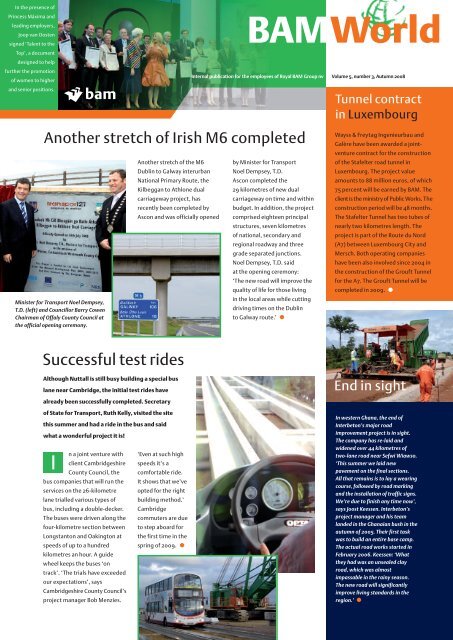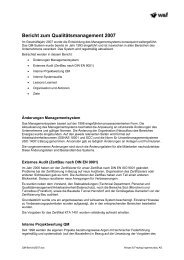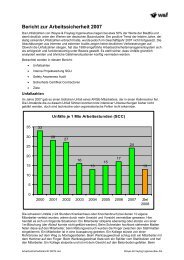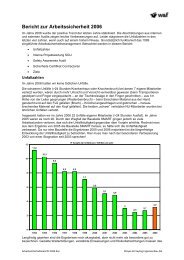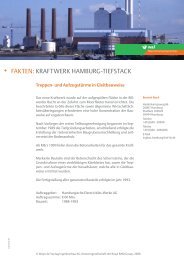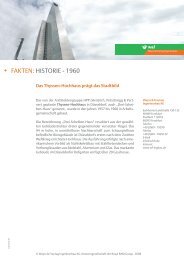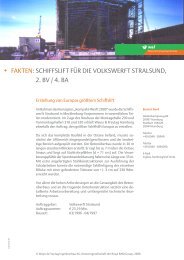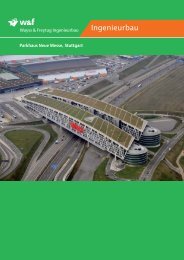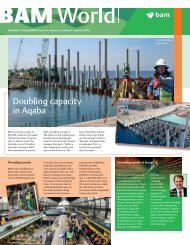Download - Royal BAM Group
Download - Royal BAM Group
Download - Royal BAM Group
You also want an ePaper? Increase the reach of your titles
YUMPU automatically turns print PDFs into web optimized ePapers that Google loves.
In the presence of<br />
Princess Máxima and<br />
leading employers,<br />
Joop van Oosten<br />
signed ‘Talent to the<br />
Top’, a document<br />
designed to help<br />
further the promotion<br />
of women to higher<br />
and senior positions.<br />
Successful test rides<br />
Although Nuttall is still busy building a special bus<br />
lane near Cambridge, the initial test rides have<br />
already been successfully completed. Secretary<br />
of State for Transport, Ruth Kelly, visited the site<br />
this summer and had a ride in the bus and said<br />
what a wonderful project it is!<br />
I<br />
n a joint venture with<br />
client Cambridgeshire<br />
County Council, the<br />
bus companies that will run the<br />
services on the 26-kilometre<br />
lane trialled various types of<br />
bus, including a double-decker.<br />
The buses were driven along the<br />
four-kilometre section between<br />
Longstanton and Oakington at<br />
speeds of up to a hundred<br />
kilometres an hour. A guide<br />
wheel keeps the buses ‘on<br />
track’. ‘The trials have exceeded<br />
our expectations’, says<br />
Cambridgeshire County Council’s<br />
project manager Bob Menzies.<br />
‘Even at such high<br />
speeds it’s a<br />
comfortable ride.<br />
It shows that we’ve<br />
opted for the right<br />
building method.’<br />
Cambridge<br />
commuters are due<br />
to step aboard for<br />
the first time in the<br />
spring of 2009.<br />
<strong>BAM</strong>World<br />
Internal publication for the employees of <strong>Royal</strong> <strong>BAM</strong> <strong>Group</strong> nv Volume 5, number 3, Autumn 2008<br />
Another stretch of Irish M6 completed<br />
Minister for Transport Noel Dempsey,<br />
T.D. (left) and Councillor Barry Cowen<br />
Chairman of Offaly County Council at<br />
the official opening ceremony.<br />
Another stretch of the M6<br />
Dublin to Galway interurban<br />
National Primary Route, the<br />
Kilbeggan to Athlone dual<br />
carriageway project, has<br />
recently been completed by<br />
Ascon and was officially opened<br />
by Minister for Transport<br />
Noel Dempsey, T.D.<br />
Ascon completed the<br />
29 kilometres of new dual<br />
carriageway on time and within<br />
budget. In addition, the project<br />
comprised eighteen principal<br />
structures, seven kilometres<br />
of national, secondary and<br />
regional roadway and three<br />
grade separated junctions.<br />
Noel Dempsey, T.D. said<br />
at the opening ceremony:<br />
‘The new road will improve the<br />
quality of life for those living<br />
in the local areas while cutting<br />
driving times on the Dublin<br />
to Galway route.’<br />
Tunnel contract<br />
in Luxembourg<br />
Wayss & Freytag Ingenieurbau and<br />
Galère have been awarded a jointventure<br />
contract for the construction<br />
of the Stafelter road tunnel in<br />
Luxembourg. The project value<br />
amounts to 88 million euros, of which<br />
75 percent will be earned by <strong>BAM</strong>. The<br />
client is the ministry of Public Works. The<br />
construction period will be 48 months.<br />
The Stafelter Tunnel has two tubes of<br />
nearly two kilometres length. The<br />
project is part of the Route du Nord<br />
(A7) between Luxembourg City and<br />
Mersch. Both operating companies<br />
have been also involved since 2004 in<br />
the construction of the Grouft Tunnel<br />
for the A7. The Grouft Tunnel will be<br />
completed in 2009.<br />
End in sight<br />
In western Ghana, the end of<br />
Interbeton’s major road<br />
improvement project is in sight.<br />
The company has re-laid and<br />
widened over 44 kilometres of<br />
two-lane road near Sefwi Wiawso.<br />
‘This summer we laid new<br />
pavement on the final sections.<br />
All that remains is to lay a wearing<br />
course, followed by road marking<br />
and the installation of traffic signs.<br />
We’re due to finish any time now’,<br />
says Joost Keessen. Interbeton’s<br />
project manager and his team<br />
landed in the Ghanaian bush in the<br />
autumn of 2005. Their first task<br />
was to build an entire base camp.<br />
The actual road works started in<br />
February 2006. Keessen: ‘What<br />
they had was an unsealed clay<br />
road, which was almost<br />
impassable in the rainy season.<br />
The new road will significantly<br />
improve living standards in the<br />
region.’
Lights on in the Hubertus Tunnel<br />
In the Hubertus Tunnel in The Hague, some of the tunnel<br />
lighting is now on, the ventilation fans have been installed,<br />
and the aid station cabinets are already in place. VTN Verkeers-<br />
& Besturingstechniek, part of <strong>BAM</strong> Infratechniek, is currently<br />
installing all the tunnel’s M&E works.<br />
Marco Beeloo.<br />
The tunnel was built by <strong>BAM</strong><br />
Civiel in a joint venture with<br />
Wayss & Freytag Ingenieurbau.<br />
‘We follow hot on the heels<br />
of the construction team and<br />
consult closely with them about<br />
the work we’re doing’, says<br />
VTN’s site agent Marco Beeloo.<br />
All the electrical installations in<br />
the southern tube, which was<br />
bored first, are in position.<br />
‘We’re now connecting them up.<br />
We won’t have so many teething<br />
troubles to contend with in the<br />
northern tube, so we’ll be able to<br />
make up time there on our M&E<br />
works’, says Beeloo.<br />
Installation involves attaching<br />
thousands of anchors to the<br />
tunnel walls. ‘Here we’re<br />
dealing with wall elements<br />
made of B70 concrete, which is<br />
much harder than the kind used<br />
in normal tunnels. The anchors<br />
Eco version of successful Xbloc<br />
<strong>BAM</strong> Infraconsult is enjoying worldwide success with its Xbloc. At the same time in<br />
IJmuiden (near Amsterdam) researchers are testing an eco version of the breakwater<br />
unit they have developed in-house. ‘2008 is the year of the big breakthrough’, says<br />
Bas Reedijk, coastal engineering team manager and spiritual father of the Xbloc.<br />
C<br />
ompared to the<br />
concrete cubes that<br />
cover many seaport<br />
jetties, the Xbloc is not only<br />
cheaper, but provides better<br />
protection. The Xbloc also scores<br />
very favourably in comparative<br />
tests with other types of<br />
breakwater unit. The ‘secret’ lies<br />
in its smart design, which not<br />
only saves on concrete, but<br />
allows the units to interlock<br />
much more effectively. Reedijk:<br />
‘Even though the concrete<br />
cubes currently used on the<br />
embankments in IJmuiden weigh<br />
forty tonnes, they’re easily<br />
<strong>BAM</strong> Civiel technicians get the<br />
formwork ready for the pour.<br />
Bas Reedijk (left) with <strong>BAM</strong> Civiel<br />
site agent Arie Bootsma.<br />
shifted around by the waves.<br />
The more complex shape of<br />
the Xblocs makes them much<br />
less susceptible to wave action.<br />
They’re also quick and easy to<br />
put into position. What all this<br />
amounts to is a<br />
considerable saving on<br />
building costs and more<br />
economical use of raw<br />
materials, which in turn<br />
reduces CO2 emissions.’<br />
The unit was first used<br />
three years ago in a<br />
harbour on the east coast of<br />
Ireland. ‘Two winters on and the<br />
blocks have withstood everything<br />
the Irish Sea has been able to<br />
throw at them. The blocks have<br />
since been used in Indonesia and<br />
Nigeria. We currently have<br />
projects on the go in Georgia,<br />
Guatemala and again in Ireland.<br />
The largest project to date is<br />
being carried out in Panama, with<br />
30,000 Xblocs being placed over<br />
a three kilometre stretch for bank<br />
protection.’<br />
are usually put into pre-drilled<br />
holes rather than shot in, but,<br />
after carrying out various tests,<br />
we decided for the sake of speed<br />
to shoot them in.’<br />
www.hubertustunnel.nl<br />
Eco version<br />
The new development is the eco<br />
version of the Xbloc, designed<br />
to enhance the ecological value<br />
of hard protective structures.<br />
The inner side walls of the steel<br />
formwork manufactured by<br />
<strong>BAM</strong> Materieel are lined with<br />
rubber mats featuring various<br />
profiles. This produces rough<br />
surfaces that make it easier for<br />
shellfish and seaweed to attach<br />
to the concrete. In early June,<br />
<strong>BAM</strong> Civiel placed ten of these<br />
blocks on IJmuiden’s southern<br />
jetty breakwater.<br />
www.xbloc.com<br />
IJmuiden<br />
Amsterdam<br />
U<br />
The Hague<br />
Rotterdam<br />
Brussels<br />
Xbloc placement in IJmuiden.
Groningen<br />
Lelystad<br />
trecht<br />
Maastricht<br />
‘Giving direction to sustainability policy’<br />
‘The formulation of the <strong>BAM</strong> Business Principles has given<br />
direction to the further development of the <strong>Group</strong>’s policy<br />
on sustainability’, says Tom van Beek.<br />
T<br />
he corporate staff<br />
department’s director<br />
of Human Resources<br />
was also appointed director of<br />
Corporate Social Responsibility<br />
(CSR) by the Executive Board<br />
from the beginning of this year.<br />
In his new position, Van Beek was<br />
closely involved in the development<br />
of the <strong>BAM</strong> Business Principles,<br />
as published in <strong>BAM</strong>’s first<br />
sustainability report.<br />
‘Sustainability has been very<br />
much in the spotlight for some<br />
years now and <strong>BAM</strong> hasn’t been<br />
sitting on its hands in this area<br />
either. Our operations occupy a<br />
central position in the community<br />
and we need to be open to all the<br />
signals the community sends us.<br />
A wide range of initiatives have<br />
already been put in place. The<br />
<strong>BAM</strong> Business Principles provide<br />
a cohesive framework for all<br />
these initiatives.’<br />
‘We decided on a realistic,<br />
pragmatic approach. We don’t<br />
commit ourselves to things we<br />
can’t deliver. There are the<br />
familiar themes of People, Planet<br />
and Profit, but with a certain<br />
degree of ambition too. We want<br />
to show our shareholders, our<br />
clients and our building partners<br />
as well as our current and future<br />
employees that we are serious<br />
about making significant inroads<br />
in sustainable development and<br />
sustainable construction.’<br />
Emphasis<br />
Now that the Business Principles<br />
are there in black and white, it is<br />
essential to take the next steps.<br />
The director of CSR: ‘Firstly, we<br />
aim to document the initiatives<br />
we’ve been developing within<br />
the <strong>Group</strong>. A good deal of<br />
In Brussels’ European district<br />
Building around an inner court<br />
Interbuild is part of a consortium building a 75,000 m2 office complex in the<br />
heart of the European district in Brussels. But this strategic location has its<br />
drawbacks. During EU summits, which are held four times a year, the district<br />
is closed off. Interbuild can continue with construction, but the movement of<br />
materials in and out is prohibited. Work is due to be completed in June 2009.<br />
From left: Martijn Berckmans, site<br />
agent, Jos Jonkers and Manu Leysen,<br />
project manager.<br />
The project, with a<br />
contract value of<br />
81 million euros, is being<br />
built for Axa Real Estate<br />
Belgium. The building<br />
has two underground<br />
floors, and at some<br />
Tom van Beek will explain the<br />
<strong>BAM</strong> Business Principles at<br />
Young <strong>BAM</strong>’s Ultrasustainability<br />
workshop.<br />
information about them is<br />
already to be found in our<br />
recently published Sustainability<br />
Report for 2007. We will also be<br />
putting an emphasis on certain<br />
areas.<br />
A start was<br />
made with<br />
the June<br />
symposium on reducing CO2 emissions. Furthermore, we<br />
want to report on various<br />
subjects in more detail. There<br />
is also a concern that we should<br />
focus on the management of<br />
locations even three. It has<br />
seven above-ground floors of<br />
offices and one level devoted to<br />
technical installations. ‘All the<br />
parties involved, including the<br />
client and architect – Atelier de<br />
Genval/ELD Partnership – use<br />
Procos, an internet platform for<br />
data exchange and approving<br />
drawings. As a tool, it’s virtually<br />
indispensable to controlling the<br />
construction process. It would<br />
be nigh on impossible to see a<br />
large project like this through<br />
without this kind of internet<br />
platform’, says senior site agent<br />
Jos Jonkers.<br />
‘<strong>BAM</strong> employees are very<br />
involved in sustainability’<br />
waste flows. Thirteen per cent<br />
of all the materials we take<br />
onto building sites is returned<br />
unused. So thirteen out of every<br />
one hundred roof tiles go back<br />
into storage.<br />
We should be<br />
able to make<br />
this issue the<br />
subject of a sustainability drive<br />
in collaboration with our<br />
building partners.’<br />
Batavia Stad<br />
extension<br />
<strong>BAM</strong> subsidiary Heilijgers is to<br />
work on Batavia Stad again.<br />
The company that helped to<br />
complete the first phase of<br />
this factory outlet centre near<br />
Lelystad (central Netherlands)<br />
in 2001 is now part of a<br />
construction team building<br />
a new 25-shop extension. The<br />
shops will be ready to shell<br />
stage by the end of this year.<br />
www.bataviastad.nl
Ashmolean in Oxford<br />
Latest techniques for oldest museum<br />
Opened in 1683, the Ashmolean Museum of Art & Archaeology<br />
at Oxford is on record as the oldest museum in the world. As<br />
part of the renowned Oxford University, it has always played an<br />
important role in education. The museum’s new home will enable<br />
it to continue to perform the full extent of this role in the future.<br />
H<br />
BG Construction<br />
is building a new<br />
exposition centre<br />
directly behind the six-metre<br />
deep main Ashmolean building<br />
with its monumental facade<br />
dating from 1875. The contract<br />
value totals 42 million euros,<br />
including the amount required<br />
to finish room interiors. The<br />
project will be completed in<br />
August 2009.<br />
Logistic puzzle<br />
Construction manager Anthony<br />
Nagle: ‘The existing structure<br />
on the site was built in the fifties<br />
and had a very inefficient floor<br />
plan. The new building will double<br />
the floor space and enable<br />
visitors to circulate more easily.’<br />
The construction site is fully<br />
enclosed by other buildings.<br />
Both sides border on university<br />
buildings, to which the new<br />
structure will be as close as<br />
25 millimetres. Only at the back<br />
is there a little more room, and<br />
that is where the only possible<br />
access to the site will run,<br />
making use of a nearly fourmetre-wide<br />
lane to the public<br />
street. ‘The problem is that we<br />
will have to cross a busy<br />
walkway along which many<br />
hundreds of pedestrians pass<br />
every day. Material deliveries<br />
will be completely impossible<br />
when the annual St. Giles fair is<br />
being held. During these four<br />
Anthony Nagle.<br />
days, we will only be able to<br />
access the construction site on<br />
foot. All in all, it is a big logistic<br />
puzzle.’<br />
Eye-catcher<br />
Because the building is fully<br />
enclosed, only the back wall<br />
has received any attention from<br />
architect Rick Mather, insofar<br />
as it is visible with a little effort<br />
from the public street. He put<br />
most of his energy into the<br />
building. Nagle: ‘The six-storey<br />
high atrium will be an eyecatcher.<br />
Since the floors on the<br />
upper storeys are spread further<br />
apart, the atrium widens out at<br />
the top. The various spaces<br />
around this atrium are accessed<br />
by means of narrow bridges<br />
supported on glass beams. A<br />
glass skylight in the roof allows<br />
daylight into the building.’<br />
The building will accommodate<br />
39 exhibition rooms, each<br />
equipped with so-called ‘fat<br />
walls’. ‘These consist of concrete<br />
structural walls with a facing<br />
wall built<br />
from<br />
steelwork<br />
covered with<br />
two layers of<br />
plywood and<br />
two layers of<br />
drywall. This<br />
creates a<br />
strong wall<br />
for attaching<br />
display cases. All the building<br />
services, including air<br />
conditioning, can be hidden<br />
in these walls.’<br />
Drawing contest<br />
The museum welcomes<br />
schoolchildren and students<br />
almost every day. To better<br />
facilitate their visits, there will<br />
be a separate entrance at the<br />
back with a reception area<br />
and a classroom. The strong<br />
association with schoolchildren<br />
was also expressed in a drawing<br />
contest. Many children were<br />
inspired during the construction<br />
activities, and HBG Construction<br />
awarded a laptop computer to<br />
each of the three prize winners.<br />
www.ashmolean.org<br />
Boring simultaneously<br />
German transport minister Wolfgang Tiefensee recently set two<br />
tunnel boring machines in motion at the same time to start work on<br />
building the Finne Tunnel. Wayss & Freytag Ingenieurbau is a joint<br />
venture partner in the construction of the seven-kilometre rail<br />
tunnel, which will form part of a new rail link between Erfurt and<br />
Leipzig in eastern Germany. The two single-track tunnels, each<br />
eleven metres in diameter, are being bored simultaneously.<br />
Meanwhile, the tunnel tubes are being excavated from the other end<br />
using traditional methods. The project will be completed in 2011.
Best score for<br />
considerate construction<br />
Independent CCS inspectors visited over seven hundred construction<br />
sites in the United Kingdom during July. HBG’s site for the new<br />
facilities at Newcastle-under-Lyme College scored a massive 39<br />
out of 40 points including six maximum scores of five out of five.<br />
The average score for all sites by all contractors was under 32;<br />
fewer than one in two hundred sites achieve a score of 39.<br />
T<br />
he measures taken<br />
at the new College<br />
include industryleading<br />
occupational health<br />
arrangements available to<br />
staff and visitors, including a<br />
fortnightly visit by a registered<br />
nurse to give toolbox talks on<br />
healthy eating and BMI, skin<br />
cancer, prostate cancer and<br />
other topics about men’s health.<br />
Appointments and drop-in<br />
sessions provide one to one<br />
confidential consultations and<br />
testing of blood pressure and<br />
blood sugar monitoring for<br />
diabetes.<br />
Further initiatives have included<br />
raising awareness of giving<br />
John Van Vooren (middle),<br />
project manager, together<br />
with Jean-Pierre Vansweevelt<br />
(right), site agent and Koen<br />
Nollet, project engineer.<br />
blood; the local NHS Stop<br />
Smoking Service will run a sevenweek<br />
support programme for<br />
operatives, staff and visitors,<br />
and the site has purchased a<br />
defibrillator and trained several<br />
staff to provide immediate<br />
emergency first aid on and<br />
off site.<br />
Community involvement and<br />
environmental initiatives include<br />
inviting local businesses to<br />
advertise on site free of charge<br />
and proving a monthly window<br />
cleaning service for neighbours.<br />
Environmental initiatives are<br />
reviewed through an Eco-<br />
Committee which has<br />
introduced carbon footprint<br />
Sliding bridge over the Albert Canal<br />
To make the Albert Canal suitable for four-barge push-tow units, the<br />
Belgian <strong>BAM</strong> subsidiary CEI-De Meyer is building a new bridge near<br />
Maastricht. The two hundred metre bridge is being fabricated in<br />
sections on the eastern bank, and the sections are slid into place across<br />
temporary piers using jacks. The interim bridge will be open to traffic<br />
at the end of this year. CEI-De Meyer will then demolish the old bridge<br />
and build new abutments and piers in its place. At the end of 2009<br />
the whole bridge will be moved sideways into its final position.<br />
A range of facilities will be integrated into the western abutment,<br />
including a bunker, a war museum with a cafeteria and an open air<br />
theatre.<br />
monitoring, promoting car<br />
sharing, and a range of recycling<br />
measures for glass, stone,<br />
aluminium and tyres. The College<br />
joins the Eco-Committee on a<br />
monthly basis.<br />
Following a visit from the<br />
Environment<br />
Agency, the site<br />
has been recommended for the<br />
Queen’s Award for Excellence.<br />
HBG’s project manager Ivan<br />
Gethin said: ‘I’m delighted we<br />
achieved maximum score for six<br />
of the eight categories assessed<br />
for the new College. It is<br />
‘39 out of 40 points’<br />
Ivan Gethin with two schoolchildren<br />
at HBG’s Newcastle-under-Lyme<br />
College site.<br />
important to us that the College’s<br />
neighbours can see we are doing<br />
our best to minimise the impact<br />
of construction and that we reach<br />
out to the community we work<br />
in to be good neighbours. I’m<br />
particularly looking forward to<br />
showing children<br />
from local schools<br />
what we do on and around<br />
the site.’<br />
Gethin is overseeing the sixtymillion-euro<br />
project, which<br />
started on site in June, and<br />
is expected to complete in<br />
September 2009.<br />
New office in Poland<br />
Tebodin SAP-Projekt, the Polish<br />
branch of the Tebodin family,<br />
has moved into a new office in<br />
Warsaw. The growth of the<br />
branch made it necessary to look<br />
for a more modern and efficient<br />
accommodation. This has been<br />
found in the Marynarska Business<br />
Park, close to the centre of the<br />
capital city. About 250 employees<br />
are working on various projects at<br />
the new location.<br />
In the photo, the Lafarge project<br />
team is meeting to discuss the<br />
recently awarded contract for<br />
the design, procurement, safety<br />
control, construction<br />
management and supervision<br />
of the extension of two cement<br />
plants for Lafarge. Both the<br />
projects in Malogoszcz and<br />
Piechcin includes the<br />
construction of storage facilities,<br />
cement mills, truck offloading<br />
installations, internal transport<br />
equipment, etcetera. The project<br />
in Malogoszcz, some two<br />
hundred kilometres south of<br />
Warsaw, will be finished in<br />
April 2009. The completion of<br />
the new facilities in Piechcin,<br />
250 kilometres northwest<br />
of the capital, is scheduled<br />
for November 2010.<br />
~<br />
~
<strong>BAM</strong> Rail shares in<br />
‘tartan’ tram deal<br />
<strong>BAM</strong> Rail has been granted a<br />
contract from Siemens as a<br />
subcontractor for the<br />
construction of a tram line in<br />
Edinburgh. The contract includes<br />
the construction of nine<br />
kilometres of double-track tram<br />
line in the centre of Edinburgh<br />
as well as ten kilometres in the<br />
direction of the suburbs and the<br />
airport to the west of the Scottish<br />
capital. The total building costs<br />
amount to approximately forty<br />
million euros. <strong>BAM</strong> Rail is<br />
responsible for the construction<br />
of nineteen kilometres of<br />
embedded rail in the centre of<br />
Edinburgh, twelve kilometres of<br />
Building restoration in<br />
Brussels’ Grote Markt<br />
The Grote Markt in Brussels has a series of magnificent historic<br />
facades that are on UNESCO’s World Heritage List. The Belgian<br />
operating company Galère is tackling five of these monumental<br />
buildings with kid gloves.<br />
Robert Giunta, Galère’s site<br />
agent: ‘We’re cleaning the<br />
facades, restoring the stone<br />
and ornaments, and are<br />
working on the windows too.<br />
A lot of the decorative elements<br />
ballasted sections and seven<br />
kilometres of tracks on a<br />
concrete surface, as well as sixty<br />
switches within the turnkey<br />
project. The embedded Rheda<br />
rail system was used for the<br />
first time by <strong>BAM</strong> Rail when<br />
constructing high-speed line<br />
‘HSL-Zuid’ in the Netherlands.<br />
<strong>BAM</strong> Rail will be using the<br />
Rheda City system, a simplified<br />
version of the ballastless track<br />
system, in Edinburgh where the<br />
rails and sleepers are concreted<br />
into place using concrete slabs.<br />
It is expected that the tram line<br />
will be delivered at the end of<br />
2010.<br />
are being given a new layer of<br />
gold leaf.’<br />
The facades are sandblasted at<br />
low pressure. Giunta: ‘The<br />
pressure is so low that only the<br />
dirt and grime are removed.<br />
Foam concrete:<br />
light and airy<br />
A work floor here, a filler layer there, and now and then even a load<br />
pumped in to fill an old sewer ... <strong>BAM</strong> Betontechnieken somehow<br />
always knows how to successfully bring the advantages of foam<br />
concrete into the limelight.<br />
‘It’s a versatile product that is<br />
quick and easy to use’, says Jan<br />
Bergsma, project manager at<br />
<strong>BAM</strong> Betontechnieken, while<br />
behind him foam concrete flows<br />
like thin yoghurt from a hose.<br />
A thirty centimetre filler layer is<br />
being poured on the top floor of an<br />
office building under construction<br />
on the flower auction site. ‘We mix<br />
the materials in situ, which avoids<br />
the inconvenience of concrete<br />
mixers coming and going’, says<br />
site agent Co van Moorselaar.<br />
Bergsma: ‘We can pour around<br />
four hundred cubic<br />
metres a day. Once it’s<br />
cured, you have a strong<br />
filler layer that can take<br />
loads of up to seventy<br />
tonnes a square metre<br />
depending on the type<br />
of foam concrete used.<br />
It’s easy to process and<br />
lightens the workload<br />
considerably.’<br />
The stone is unaffected. The<br />
machine is turned on at five<br />
o’clock in the morning. At ten<br />
we have to stop and remove all<br />
the sealing materials we’ve put<br />
around windows and doors. The<br />
protective tarpaulin around the<br />
scaffolding is rolled up so that<br />
Like thin yoghurt ...<br />
Weak peat soil<br />
Foam concrete also seems to be<br />
a hot item in the civil engineering<br />
sector as well as in residential and<br />
non-residential construction.<br />
<strong>BAM</strong> Betontechnieken recently<br />
used it for the foundations of<br />
a road built over weak peat soil.<br />
Bergsma: ‘To prevent subsidence<br />
and to avoid giving vermin a place<br />
to nest, we also fill in old sewers.<br />
In Amsterdam this year, we’ll be<br />
using close to a thousand cubic<br />
metres of foam concrete to do<br />
just that.’<br />
Jan Bergsma (left)<br />
and Co van Moorselaar.<br />
visitors can see the shop<br />
windows and the entrances<br />
to the brewery museum and<br />
the restaurant. We are allowed<br />
to work above them on the<br />
scaffolding as long as we<br />
keep the noise down.’<br />
Design Boulogne Jonkers, Zoetermeer<br />
Photography De Beeldredaktie, René van den Burg, Dries Vandenbrande<br />
Printing Thieme Media Services, Delft<br />
<strong>BAM</strong> World is compiled by Monica van Soldt, <strong>Royal</strong> <strong>BAM</strong> <strong>Group</strong> nv,<br />
Public Relations Department: +31 (0)30 659 86 22, m.van.soldt@bamgroep.nl


